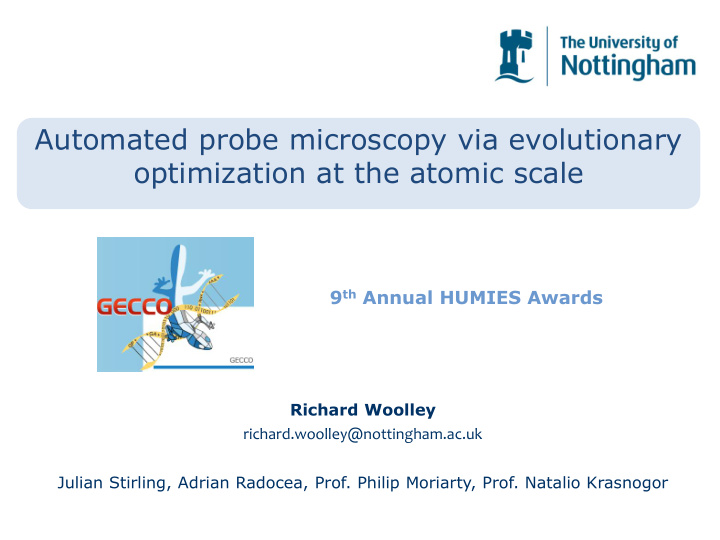



Automated probe microscopy via evolutionary optimization at the atomic scale 9 th Annual HUMIES Awards Richard Woolley richard.woolley@nottingham.ac.uk Julian Stirling, Adrian Radocea, Prof. Philip Moriarty, Prof. Natalio Krasnogor
The Power of Scanning Probe Microscopy Imaging individual molecules and resolving sub molecular structure Gross et al. Science 325, 1110 (2009) The ability to fabricate electronic devices (a single atom transistor) with atomic precision. Fuechsle et al. Nature Nanotechnology 7, 242 – 246 (2012) The importance of the probe structure; a single H atom at the probe apex inverts the image contrast. Sharp et al. Appl. Phys. Lett. 100, 233120 (2012) Richard AJ Woolley Evolutionary optimization at the atomic scale 2
Scanning Tunneling Microscopy User Imaging parameters: parameters: Tunnel current, i t V i G Voltage, V Gain, G Z(i=i t ) i t ∝ Vexp (−2kz ts ) feedback control gain G Where the tip-sample separation, z ts , is maintained by a feedback loop of gain, G. Z Y X Actuator Nanoscale: motion Tip apex i t Probe or tip Tunneling z ts electrons V Sample Macroscopic scale Richard AJ Woolley Evolutionary optimization at the atomic scale 3
30 years without a solution, until now (Criteria E & G) • Thousands of users world wide • Expensive machine and operator costs • Many hours spent manually optimising images The problems: • Changing tip state and, • Obtaining the optimum imaging parameters V, i and G Richard AJ Woolley Evolutionary optimization at the atomic scale 4
Fitness and the cGA Imaging parameters V i Fitness=RMI(T,I) G Target Image, T Acquired Image, I The cGA: An individual, n, with imaging parameters V n , i n and G n V N-1 , i N-1 , G N-1 V N , i N , G N The population of N individuals, each with imaging parameters V, i, G E.Alba and B. Dorronsoro, Cellular Genetic Algorithms (Springer 2008) ; Q.H. Quang et al., Evol. Comp. 17 231 (2009) Richard AJ Woolley Evolutionary optimization at the atomic scale 5
The cGA in operation (Criteria F) Start Target Images taken by microscope for • the individual’s parameters V, i, G Migrate good V, i, G • Generation vs. Fitness Generation Final= Richard AJ Woolley Evolutionary optimization at the atomic scale 6
Can we choose different tip states? (Criteria E & D) α Honeycomb Triangular β 3.35Å Triangular image Honeycomb target Triangular target Honeycomb image R.A.J. Woolley, J.Stirling, A. Radocea, N. Krasnogor, and P.J. Moriarty, Appl. Phys. Lett. 98, 253104 (2011) Richard AJ Woolley Evolutionary optimization at the atomic scale 7
Is it comparable to the human operator? (Criteria H) Results of the challenge Microscopist Average Change in image image quality quality per min Machine 0.20* 7.1* Human 0.09 2.6 *winner A selection of the machine optimised images: The Competition (Human vs. Machine): Obtain the best image possible within 1 hour (4x4nm 2 ) Richard AJ Woolley Evolutionary optimization at the atomic scale 8
Criteria for human-competitiveness (A) The result was patented as an invention in the past, is an improvement over a patented invention, or would qualify today as a patentable new invention • New invention • Working with the leading manufacturer (D) The result is publishable in its own right as a new scientific result independent of the fact in was mechanically created. • R.A.J. Woolley, J.Stirling, A. Radocea, N. Krasnogor, and P.J. Moriarty, Appl. Phys. Lett. 98, 253104 (2011) • The same journal as the original Nobel prize wining invention (E) result >= the most recent human-created solution to a long- standing problem for which there has been a succession of increasingly better human-created solutions. • The human operator was the solution Richard AJ Woolley Evolutionary optimization at the atomic scale 9
Criteria for human-competitiveness (F) result >= a result that was considered an achievement in its field at the time it was first discovered. • The system is state of the art (G) The result solves a problem of indisputable difficulty in its field. • “That’s impossible” • “Can we have it, please?” (H) The result holds its own or wins a regulated competition involving human contestants (in the form of either live human players or human-written computer programs) • The ‘Nano - machine’ won! Richard AJ Woolley Evolutionary optimization at the atomic scale 10
Summarising why this entry is best! A step-wise change in STM operation for over 30 years An underpinning technology for the wider scanning probe instrumentation sector Innovative Greatly improved productivity State of the art Meets 6 out of the 8 criterion It’s just the tip of the iceberg…. Richard AJ Woolley Evolutionary optimization at the atomic scale 11
Potential Future Impact C 60 molecules on Si(111) 7x7 What does the future hold for a robot that can recognise atoms and molecules… ….and can develop the nanoscale tools and necessary protocols to manipulate those atoms and molecules? Image courtesy of S. Jarvis What would you get the robot to build? What if it evolved things that it wanted to? Richard AJ Woolley Evolutionary optimization at the atomic scale 12
Thanks Julian Stirling and Prof. Philip Moriarty School of Physics and Astronomy, The University of Nottingham, University Park, Nottingham, England Prof. Natalio Krasnogor Computer Science, The University of Nottingham, Jubilee Campus, Nottingham, England Adrian Radocea The authors would like to thank Department of Materials Science and Engineering, the EPSRC (Grant no: University of Illinois at Urbana-Champaign, EP/H010432/1) and the European Commission’s ICT -FET Urbana, Illinois 61801, USA programme via the Atomic Scale and Single Molecule Logic gate Technologies (AtMol) project, Contract No. 270028 for providing financial support to this project. richard.woolley@nottingham.ac.uk www.nottingham.ac.uk/physics/research/nano http://icos.cs.nott.ac.uk/ Richard AJ Woolley Evolutionary optimization at the atomic scale 13
Recommend
More recommend